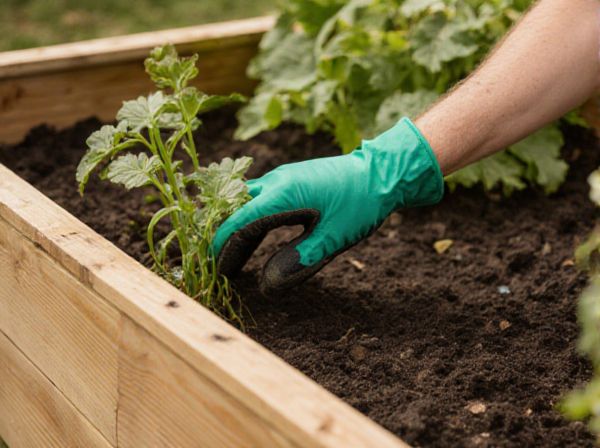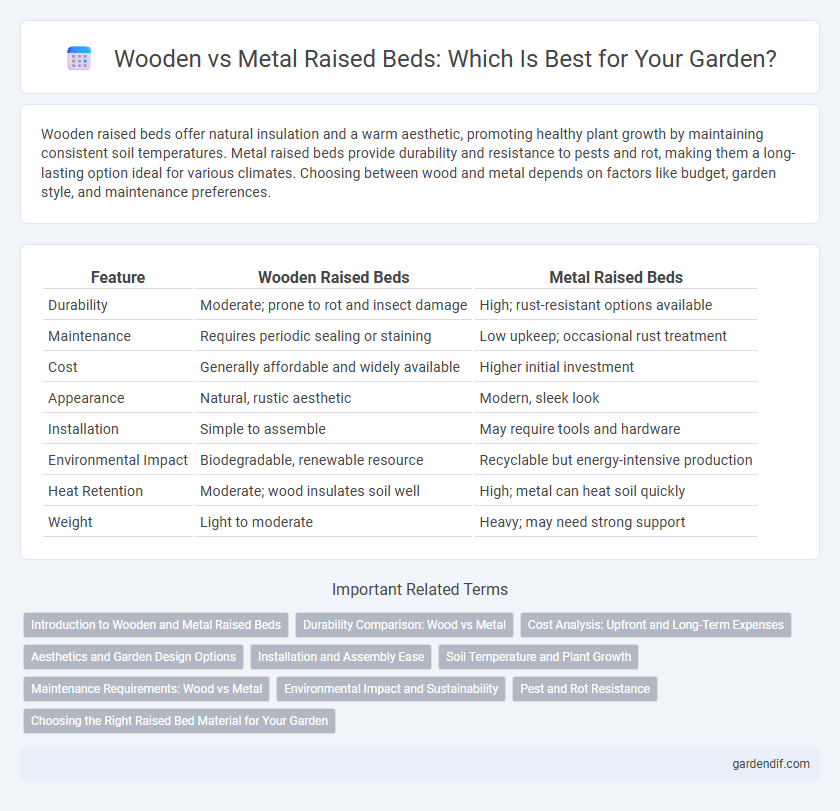
Wooden raised beds vs metal raised beds Illustration
Wooden raised beds offer natural insulation and a warm aesthetic, promoting healthy plant growth by maintaining consistent soil temperatures. Metal raised beds provide durability and resistance to pests and rot, making them a long-lasting option ideal for various climates. Choosing between wood and metal depends on factors like budget, garden style, and maintenance preferences.
Table of Comparison
| Feature | Wooden Raised Beds | Metal Raised Beds |
|---|---|---|
| Durability | Moderate; prone to rot and insect damage | High; rust-resistant options available |
| Maintenance | Requires periodic sealing or staining | Low upkeep; occasional rust treatment |
| Cost | Generally affordable and widely available | Higher initial investment |
| Appearance | Natural, rustic aesthetic | Modern, sleek look |
| Installation | Simple to assemble | May require tools and hardware |
| Environmental Impact | Biodegradable, renewable resource | Recyclable but energy-intensive production |
| Heat Retention | Moderate; wood insulates soil well | High; metal can heat soil quickly |
| Weight | Light to moderate | Heavy; may need strong support |
Introduction to Wooden and Metal Raised Beds
Wooden raised beds offer natural aesthetics and ease of customization, commonly constructed from cedar or redwood for durability and resistance to rot. Metal raised beds, often made from galvanized steel or aluminum, provide longevity, strength, and resistance to pests and weather elements. Selecting between wooden and metal raised beds depends on factors such as garden design preferences, budget, and intended lifespan.
Durability Comparison: Wood vs Metal
Wooden raised beds offer natural insulation and aesthetic appeal but may be prone to rot, insect damage, and weathering within 5-10 years unless treated with protective sealants. Metal raised beds, typically made from galvanized steel or aluminum, provide superior durability, resisting rust and corrosion for 15-20 years or more with minimal maintenance. Choosing metal raised beds ensures longer-lasting structural integrity and better resistance to environmental factors compared to most wooden options.
Cost Analysis: Upfront and Long-Term Expenses
Wooden raised beds typically have a lower upfront cost due to the affordability of materials like cedar or pine, but they may require replacement or treatment every 3-5 years, increasing long-term expenses. Metal raised beds often have a higher initial investment, especially with galvanized steel or aluminum, but they offer greater durability and resistance to rot, reducing maintenance costs over time. Considering lifespan and maintenance, metal raised beds can be more cost-effective for long-term gardening projects despite the higher initial outlay.
Aesthetics and Garden Design Options
Wooden raised beds offer a natural, rustic appearance that blends seamlessly with traditional garden settings, enhancing organic aesthetics and providing versatile design flexibility such as varied shapes and stacked planting options. Metal raised beds present a sleek, modern look with clean lines and durable finishes that suit contemporary or industrial garden designs while allowing for modular arrangements and color customization. Both materials support diverse planting styles, but the choice impacts overall garden ambiance and style coherence.
Installation and Assembly Ease
Wooden raised beds typically offer straightforward installation with basic tools like a screwdriver or drill, and their pre-cut panels often allow for quick assembly. Metal raised beds may require additional hardware and precise alignment due to their interlocking parts, sometimes complicating the setup process. Choosing wooden raised beds can minimize installation time, especially for gardeners seeking a simple, user-friendly assembly experience.
Soil Temperature and Plant Growth
Wooden raised beds naturally insulate soil, maintaining warmer temperatures ideal for early planting and promoting robust root development. Metal raised beds tend to heat up faster but can experience greater temperature fluctuations, which might stress plants during extreme heat or cold. Choosing wooden beds enhances consistent soil warmth, fostering steady plant growth throughout the growing season.
Maintenance Requirements: Wood vs Metal
Wooden raised beds require regular maintenance such as sealing, staining, or painting to prevent rot, insect damage, and weathering, typically needing attention every 2-3 years. Metal raised beds, often made from galvanized steel or aluminum, offer superior durability with minimal maintenance, resisting rust and corrosion without the need for protective coatings. Proper drainage and inspection for rust spots are essential for metal beds to ensure longevity, while wood beds demand more frequent upkeep to maintain structural integrity and aesthetic appeal.
Environmental Impact and Sustainability
Wooden raised beds, especially those made from sustainably sourced or reclaimed wood, offer a lower carbon footprint and better biodegradability compared to metal raised beds, which rely on energy-intensive mining and processing. Metal raised beds, although durable and often recyclable, can contribute to environmental degradation through resource extraction and may leach harmful substances if not properly coated. Choosing untreated, natural wood or recycled metal options enhances sustainability by reducing waste and minimizing chemical impact on soil and ecosystems.
Pest and Rot Resistance
Wooden raised beds typically require treatment to resist rot and insect damage, with cedar and redwood offering natural pest deterrent properties, but they remain susceptible to decay over time. Metal raised beds boast superior durability and natural resistance to rot and pests, eliminating concerns over wood-boring insects and fungal decay. Choosing metal raised beds ensures a longer lifespan and less maintenance in pest control compared to traditional wooden options.
Choosing the Right Raised Bed Material for Your Garden
Wooden raised beds offer natural insulation and a classic aesthetic, promoting healthy root growth by regulating soil temperature effectively. Metal raised beds provide durability and resistance to pests, with materials like galvanized steel preventing rust and extending garden bed longevity. Selecting between wood and metal depends on factors such as climate, budget, maintenance preferences, and desired appearance, ensuring optimal plant health and garden productivity.
Wooden raised beds vs metal raised beds Infographic

 gardendif.com
gardendif.com